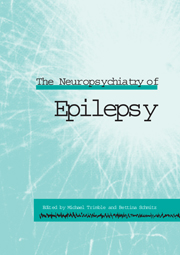Book contents
- Frontmatter
- Contents
- List of contributors
- Part I Background
- 1 Introduction
- 2 Neuropsychiatric disorders in epilepsy – epidemiology and classification
- 3 Limbic connectivity: anatomical substrates of behavioural disturbances in epilepsy
- Part II Clinical aspects
- Part III Cognitive aspects
- Part IV Nonepileptic attacks
- Part V Treatment complications
- Part VI Treatment
- Index
3 - Limbic connectivity: anatomical substrates of behavioural disturbances in epilepsy
Published online by Cambridge University Press: 05 October 2010
- Frontmatter
- Contents
- List of contributors
- Part I Background
- 1 Introduction
- 2 Neuropsychiatric disorders in epilepsy – epidemiology and classification
- 3 Limbic connectivity: anatomical substrates of behavioural disturbances in epilepsy
- Part II Clinical aspects
- Part III Cognitive aspects
- Part IV Nonepileptic attacks
- Part V Treatment complications
- Part VI Treatment
- Index
Summary
Introduction
Behavioural disturbances associated with epilepsy are due, in part, to a number of important psychological and social factors; however, it is useful to acknowledge that there are neurobiological factors as well. Not only does identification of organic bases for behavioural aberrations help reduce the stigma they invariably engender, but also it provides a rational scientific approach to prevent or reverse a significant cause of disability experienced by persons with epilepsy.
Cognitive and psychiatric disturbances associated with epilepsy may be due to the same underlying pathological process that causes the epileptic condition, and there is evidence that behavioural impairment may be related to the pathophysiological nature of the underlying lesion, its effect on development and its location (Engel et al., 1986; Engel and Shewmon, 1991). With respect to location, mesial temporal and other limbic epileptogenic lesions are most likely to be associated with behavioural disturbances (Engel et al., 1986; Engel and Shewmon, 1991). Temporal lobe epilepsy is the most common form of human epilepsy, and hippocampal sclerosis is the most common human epileptogenic lesion (Engel, 1998). Furthermore, mesial temporal lobe epilepsy with hippocampal sclerosis may be the most refractory to antiepileptic drugs (Engel, 1998). Consequently, limbic system dysfunction is undoubtedly the most important cause of behavioural disturbances associated with epilepsy.
Epileptogenicity itself is known to cause enduring changes in brain function and structure in a number of ways which can result in altered behaviour.
- Type
- Chapter
- Information
- The Neuropsychiatry of Epilepsy , pp. 18 - 38Publisher: Cambridge University PressPrint publication year: 2002
- 7
- Cited by



